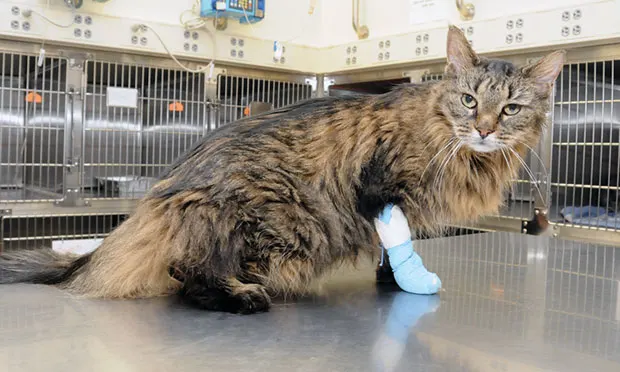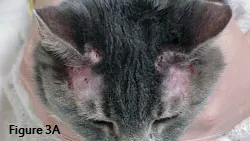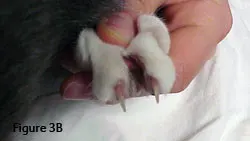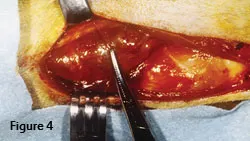Feline Hyperthyroidism
Orla Mahony, MVB, DECVIM, DACVIM (SAIM), Cummings School of Veterinary Medicine at Tufts University

Profile
Definition
Hyperthyroidism is a hypermetabolic state caused by excessive production and secretion of thyroid hormones.
Systems
Hyperthyroidism can affect all body tissues directly or indirectly as a result of secondary hypertension.
Signalment
Mean age of affected cats is 13 years (range, 4–24 years).1
Two case control studies reported greater risk for female cats.2,3
Causes
The majority of hyperthyroid cats have benign adenomatous nodular hyperplasia, similar to toxic nodular goiter in humans.
Both lobes of the thyroid gland are typically involved.
Risk Factors
Case control studies have identified risk factors such as iodine deficiency, iodine content of canned food, cat litter, fish, liver- or giblet-flavored canned food, fire-retardant chemicals, and bisphenols in pop-top cans.4
At a molecular level, decreased expression of inhibitory
G proteins associated with the thyrotropin receptor has been found in adenomatous thyroid tissue.
This could contribute to excess secretion of thyroid hormone.
Signs
Clinical signs include weight loss and poor body condition (87%; Figure 1), polyphagia (49%), vomiting (44%), polyuria and polydipsia (36%), diarrhea (15%), weakness (12%), and voluminous stool (8%).5
Restlessness (40%), skin changes (36%), and respiratory signs (23%) are also common.1
Lethargy and anorexia (7%)5 may be seen with concurrent disease (eg, occult hyperthyroidism).1
Physical examination findings include palpable thyroid nodule (83%; Figure 2), weight loss (65%), heart murmur (54%), tachycardia (42%), and increased nail growth (6%).5
Less common abnormalities include retinal hemorrhage, retinal vessel tortuosity, retinal detachment, dyspnea, and ventral neck flexion.1,5

Diagnosis
Definitive
Diagnosis should be pursued based on supportive signalment, history, and examination findings.
Hyperthyroidism is usually diagnosed by documenting elevations in serum concentrations of total thyroxine (TT4), a highly specific and sensitive test for the diagnosis of feline hyperthyroidism.
The serum T4 level alone will be diagnostic in over 90% of hyperthyroid cats.
Measurements of total triiodothyronine (TT3) concentrations are not helpful and have no role in the diagnosis of hyperthyroidism, as 30% of hyperthyroid cats have a normal TT3.
If hyperthyroidism is suspected and TT4 is within the reference range, consider rechecking the TT4 concentrations up to several weeks later, as concentrations may fluctuate in and out of normal range.
A high-normal TT4 in a middle-aged to older cat is suspicious for hyperthyroidism.
Concurrent disease may also suppress thyroid levels (effect of nonthyroidal illness).1
Additional tests to consider include measurement of free T4 (fT4) concentration (See Free T4), T3 suppression testing, and nuclear scintigraphy.
The T3 suppression test involves administration of 25 μg of liothyronine PO q8h for 2 days.
On the morning of day 3, a third dose of 25 μg should be administered.
Blood should be drawn at baseline and 2 to 4 hours after administration of the final pill for measurement of TT3 and TT4.
Hyperthyroid cats have a TT4 concentration >2 μg/dL.
Healthy cats have a TT4 concentration <1.5 μg/dL.
Values between 1.5 and 2 μg/dL are nondiagnostic.
The T3 suppression test is useful for diagnosis of mild hyperthyroidism when TT4 and fT4 are nondiagnostic; however, consistent owner administration of pills for 3 days is difficult and failure could result in a false-positive diagnosis.
Nuclear scintigraphy is typically performed at specialized centers (eg, university hospitals, referral facilities).
Technetium-99m is commonly used; it is trapped and concentrated in the thyroid and has a short half-life.
Uptake is compared with uptake in the zygomatic salivary glands.6
Ectopic (<5% of hyperthyroid cats) and metastatic tissue can also be detected.
Differential
Differential diagnosis includes renal disease, diabetes mellitus, GI lymphoma, exocrine pancreatic insufficiency, inflammatory bowel disease, liver disease, and heart disease.
Laboratory Findings/Imaging
Minimum Database
In cats with hyperthyroidism, results of CBC should show normal to elevated RBCs (21%), PCV (47%), and mean corpuscular volume (44%).4
Alkaline phosphatase (75%) and alanine transaminase (71%) activities will be mildly elevated.4
Urine specific gravity ranges from 1.009–1.050 (mean, 1.031).4
Fructosamine concentrations are decreased below the normal range in 50% of hyperthyroid cats because of accelerated protein turnover.
Fructosamine may not be useful to monitor diabetes or distinguish between stress hyperglycemia and diabetes with concurrent hyperthyroidism.
Thoracic radiographs may show cardiomegaly, pulmonary edema, or pleural effusion.
Abdominal radiographs can rule out concurrent conditions and identify small kidneys.
Ancillary Testing
Echocardiography and electrocardiography can determine whether cardiac changes represent primary cardiac disease or changes secondary to hyperthyroidism are potentially reversible.Blood pressure measurement should be part of the evaluation.
In a study of hypertensive cats with ocular abnormalities, hyperthyroidism was found to be an uncommon cause; however, many cats with hyperthyroidism have concurrent renal disease that can contribute to hypertension.
Consider treatment if repeated measurements of systolic blood pressure are >160 mm Hg and if there is evidence of end-organ damage.
fT4 = free thyroxine, T3 = triiodothyronine, T4 = thyroxine, TT3 = total triiodothyronine, TT4 = total thyroxine
Methimazole drug reaction: (3A) self-induced excoriation of face, (3B) excoriations between the toes.

Treatment
Hyperthyroidism can be treated with radioactive iodine and surgery or controlled with drug therapy or a therapeutic diet.
Radioactive iodine is generally the best therapy but may be unavailable and/or unaffordable for owners.
Treatment is tailored to the needs of each cat, household, and owner.

Methimazole
Is readily available, reliable, convenient, and inexpensive short-term, but is potentially toxic, requires daily administration, and disease control is dependent on compliance.
Competes for iodine with tyrosine residues on thyroglobulin and prevents the coupling of diiodotyrosine and monoiodotyrosine.
This prevents formation of T4 and T3.
Typical starting dose is 2.5 mg q12h, but some mildly affected cats may be controlled with 1.25 mg q12h or 2.5 mg q24h.
Adverse effects are dose related.
Less than 5% of adverse effects (ie, leukopenia, thrombocytopenia, hepatopathy) are life threatening.
Other side effects include eosinophilia, lymphocytosis, self-induced excoriations (up to 15%), positive ANA, vomiting, and anorexia (up to 20%).
Vasculitis may be the cause of the skin excoriations (Figure 3).
Agranulocytosis is thought to be immune-mediated.
Treatment goal is to have TT4 concentrations in the low-normal range within 1 month.
If TT4 is not decreasing, rule-outs include problems medicating the cat, infrequent or inadequate dose, and thyroid carcinoma (rare).
There are various formulations of methimazole:
Can be formulated as a lecithin gel for transdermal use in cats that are difficult to pill.
Felimazole (dechra-us.com) is a coated pill available in 2.5 mg and 5 mg sizes and is FDA-approved for use in cats.
Radioactive Iodine
Curative therapy, noninvasive, with rapid response.
Disadvantages include expense, availability, and need for short-term hospitalization.
Cats need to be monitored for hypothyroidism and azotemia posttreatment.
Actively taken up by hyperplastic thyroid tissue.
Destroys the diseased tissue and spares the atrophied normal tissue.
Dose range is typically between 3.5 to 5.4 mCi administered PO, SC, or IV.
Hospitalization varies widely, depending on the agency licensing the facility.
Treatment is successful in 94% of cats.
2% of cats become hypothyroid, 1.5% remain hyperthyroid, and 2.5% relapse within 1–6.5 years of treatment.

Surgical excision of a thyroid nodule.
Thyroidectomy
Multiple techniques have been described to remove the thyroid glands (ie, extracapsular, intracapsular, modified intracapsular, and staged thyroidectomy; Figure 4)
Approximately 80% of cats have bilateral involvement.
Scintigraphy may be helpful to localize ectopic thyroid tissue and identify the approximately 5% of cats that do not benefit from surgery.
Surgery is beneficial, curative, and usually permanent.
Risks include damage to recurrent laryngeal nerves and hypoparathyroidism; disadvantages include anesthesia risks in cats with concurrent heart and kidney disease.
Cats that become hypothyroid and azotemic postoperatively need to be treated.
Follow-up
Hypothyroidism is more likely to occur following definitive therapy and, if accompanied by azotemia, is associated with shorter survival time.7
Kidney values and TT4 should be monitored every 2–4 weeks for up to 3 months following therapy.
If azotemia is accompanied by hypothyroidism, institution of lifelong replacement thyroxine therapy must be considered; this may help improve renal blood flow and glomerular filtration rate.8
Methimazole
Check TT4 concentrations, CBC, platelet count, and serum biochemistry profile q3–4wk for the first 3 months, then at 6 months and q6–12mo thereafter.
Evaluate for evidence of drug reaction (ie, cytopenia, liver enzyme elevations), hypothyroidism, hyperthyroidism, and azotemia.
Prescription Diet
Monitor TT4 concentrations and serum kidney values 4 weeks after starting diet; TT4 should be decreased after 4 weeks and normal within 8 weeks in 85% of cats.
If concentrations remain elevated, evaluate diet history (including water source).
Surgery
Monitor for hypocalcemia immediately after surgery, and for hypothyroidism and azotemia in the weeks and months following surgery.
Supplement with levothyroxine if needed.
Radioactive Iodine
Monitor for development of azotemia and hypothyroidism post therapy.
Treat with levothyroxine as needed.
In General
Relative Cost
Hyperthyroidism is a costly but rewarding disease to treat: $$$$$
Prognosis
Excellent for cats with uncomplicated hyperthyroidism.
Varies for cats with severe hyperthyroidism or when concurrent disorders are present.
Outcome will depend on successful management of thyroid complications and comorbid disease.
Average survival after successful treatment is 2 years.
Nutrition Management
Hyperthyroidism & Renal Disease
Related ArticlesFeline Occult HyperthyroidismFeline Hyperthyroidism